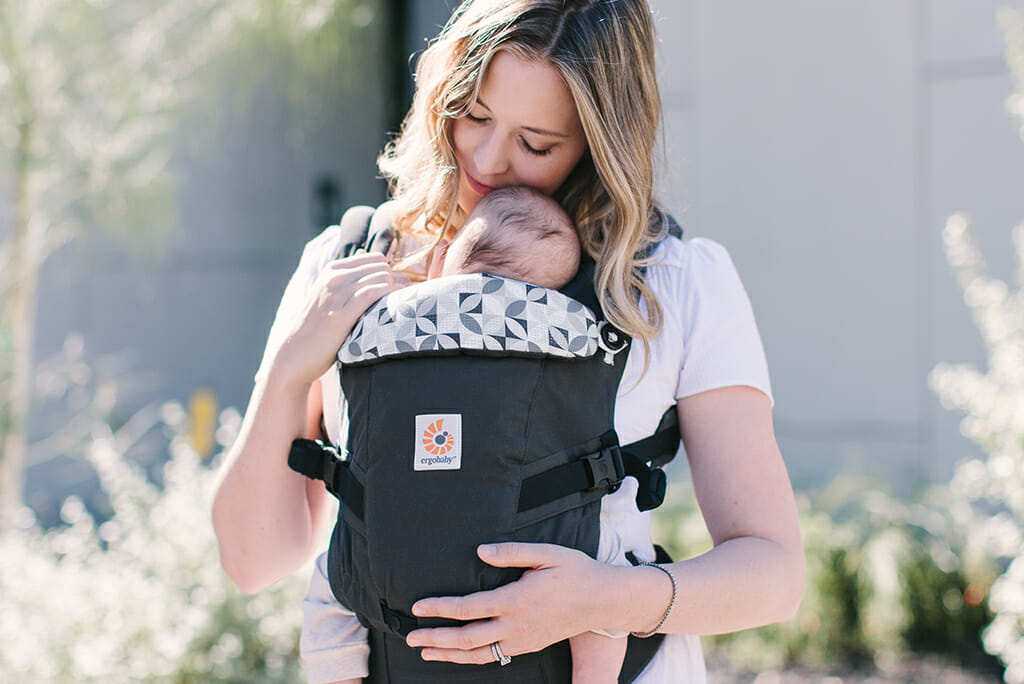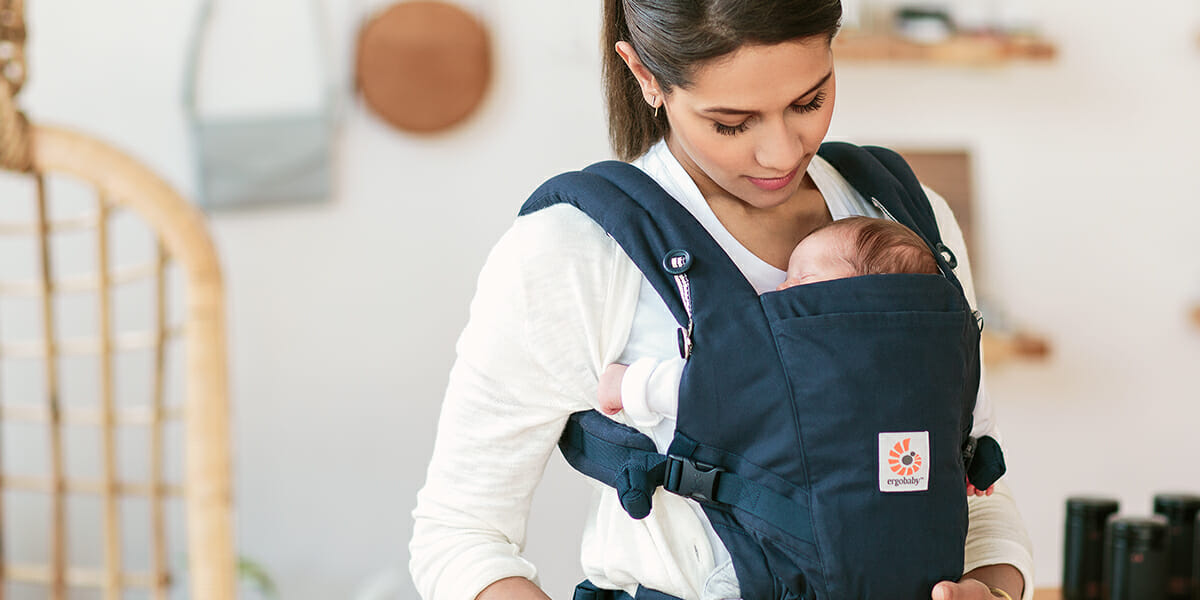
Dr Henrik Norholt writes about how using a babywearing may influence your baby’s brain development.
About Dr Henrik
Dr. Henrik Norholt is a member of The World Association of Infant Mental Health, The Marcé Society for Perinatal Mental Health and The Society of Emotion and Attachment Studies. He is an expert in the effects of baby carrying on child psychological and motor development having studied it for the past 15 years. He is a frequent lecturer and thesis supervisor at numerous universities, colleges, association meetings and international conferences.
Many of us have had quite profound personal experiences with carrying our babies. Some have witnessed how carried children often become unusually positive, empathic and robust, and we tend to ascribe this positive development of our children and of our mutual relationship with them to the fact that we carried our children, and hence provided extensive early contact.
Some have chosen to take additional training to enable other parents to have similar positive experiences with carrying their babies. There is now also an international movement to create medical recognition for the practice of extended early contact and establish a medical subspecialty profession of babywearing consultancy, so that all parents can be supported to engage in babywearing through the formal perinatal health care system.
To bring about such medical recognition, these personal experiences, however valuable they are to each one of us individually, fall short of the requirements of modern medicine. Modern medicine has to be evidence-based, which means that for any new practice to be implemented and supported by medical doctors, there has to be rigorous scientific studies demonstrating the impact of the practice.
For the practice of babywearing, the types of outcomes studied this far have mainly been so-called infant behavioral outcomes.1–4 Such studies focus on the baby’s vocalisations, body language, eye contact, facial expressions, etc. The studies of the behavioral effects of babywearing have been made possible through previous decades of other researchers’ (predominantly psychologists and psychiatrists) most detailed studies of children’s development, through which we now know what is positive or adaptive behaviors of children even when they are just a few months old.5–7 Some approaches even assess the behaviors of newborns, which are quite predictive of later psychological development.8 In recent years, both psychology and psychiatry researchers have embraced new and more bodily grounded approaches, such as brain imaging studies.9 For medical doctors, who historically have specialized in the physical side of health and physical cures for illnesses, such bodily-grounded measurement approaches (e.g. brain imaging) tend to be more credible.
It is therefore very exciting that a group of researchers at one of the world’s most prestigious universities, Columbia University in New York City, has taken upon them to conduct rigorously controlled brain imaging studies of babies, whose mothers provided them with some physical contact, and compared them with babies who received less or none at all during their early life outside the womb.10
The children studied were preterm infants, born between gestational ages week 26 and week 34. The approach employed by the researchers has been named The Family Nurture Intervention (FNI) and is unique in that it employs a range of mother-infant activities, designed to strengthen their mutual emotional bond during the preterm infant’s stay in the neonatal intensive care unit: Providing the infant with cotton-scent cloths, which the mother had worn; supporting the mothers’ manual touching of the infant and affective vocal expressions towards as well as eye contact with the infant when placed in the incubator, and upon the infant reaching medical stabilization, skin-to-skin contact or, alternatively, non-skin-to-skin contact holding in arms, while also engaging in vocal proto-conversations and eye-to-eye contact.
In the two brain-imaging studies we will describe here, the infants exposed to the intervention (“FNI-infants”) were compared to another group, which received the standard incubator care (“SC-infants”).
The research group employed a method called Electroencaphalogram (“EEG”) recording, whereby a net supporting more than hundred electrodes are placed over the infant’s head, recording the activity of the brain.
In the studies, the recordings of the infants’ brain activity were exposed to two different analyses. One analysis found that the FNI-infants had significantly increased frontal brain activity (“EEG power”), which other research has demonstrated is predictive of improved neurobehavioral outcomes.11 The other analysis demonstrated that coherence in FNI infants was decreased in the very same regions where the research group previously found robust increases in EEG power. As coherence decreases with age, the results suggest that FNI may accelerate brain maturation particularly in frontal brain regions, which have been shown in research by others to be involved in regulation of attention, cognition and emotion regulation; domains deficient in preterm infants.12

What makes these studies even more interesting is that research group followed up these brain-imaging studies with measurements of the very same children’s cognitive and behavioral development when they had reached the age of 18 months. By conducting this follow-up, we get an even better assessment of the validity of these early brain measurements.
Here is what they found: At the age of 18 months, children exposed to the Family Nurture Intervention during prematurity showed significantly improved cognitive and language scores. These children also had fewer attention problems and showed less risk of developing autism, compared to the group which received standard incubator care.13
From these findings, we can conclude that an intervention that facilitates emotional interactions between mothers and infants in the neonatal intensive care unity may be key to altering developmental trajectories of preterm infants, affecting, in the long-term, multiple fundamentally important domains of neurodevelopment, social-relatedness as well as attention regulation.
A comparison of the individual components of the Family Nurture Intervention, which is aimed a preterm infants, with the practice of babywearing of full-term infants reveals that virtually all of the FNI components are also present in regular babywearing. The full-term infant receives plenty of olfactory cues (smells) of the parent while carried. By reason of the virtuous circle, whereby carried infants are able to sustain the “quiet alert state” longer (the optimum infant state for taking in information about the outside world) and also quite early solicit social engagements from their caregivers,14 babywearing parents are more likely to engage in positive emotional proto-conversations and eye contact with their infants. The skin-to-skin contact practice of the Family Nurture Intervention is virtually identical to the practice of babywearing, except for the isolation from the clothing barrier. We have discussed the current research on this topic in a previous article.15

credit : @carolineannmccartney | Ergobaby Aura Baby Wrap
Is it likely that we would find similar significant differences in brain development between full-term infants who are carried extensively and those infants kept predominantly separated in infant containers, such as car seats, bouncers, strollers, cribs, etc.?
First of all, in the relatively few longitudinal studies of carried/skin-to-skin contact full-term infants, we do find significant and strong differences in especially their social-relatedness, as measured via the so-called still face test or the strange situation test.1,2,4,16 If the relation described in the above, namely that the quality of infants’ behavior is predicted by the infant brain’s activity patterns, we ought to be able to find similar differences in brain development amongst carried versus mostly separated full term infants.
The FNI research group described in the above employed EEG measurements of the brain activity. However, in recent years, a range of other brain imaging methods has investigated the links between infant behavioral development and brain development.9,17–22 There ought to be a rich and fertile field for those brain imaging research groups, interested in testing a potential powerful and easily implementable low cost intervention, which appear to have great promises for many of the psychological and physiological ills that afflict today’s youth.
References :
- Anisfeld E, Casper V, Nozyce M, Cunningham N. Does infant carrying promote attachment? An experimental study of the effects of increased physical contact on the development of attachment. Child Dev. 1990;61(5):1617-1627.
- Bigelow AE, Power M. The effect of mother-infant skin-to-skin contact on infants’ response to the Still Face Task from newborn to three months of age. Infant Behav Dev. 2012;35(2):240-251. doi:10.1016/j.infbeh.2011.12.008
- Bigelow AE, Power M, MacLean K, et al. Mother-Infant Skin-to-Skin Contact and Mother-Child Interaction Nine Years Later. Soc Dev. In Press.
- Williams LR. Rev. 2018.
- Cassidy J, Shaver PR. Handbook of Attachment, Third Edition: Theory, Research, and Clinical Applications. Guilford Publications; 2016.
- Murray L. The Psychology of Babies: How Relationships Support Development from Birth to Two. Robinson; 2014.
- Beebe B, Jaffe J, Markese S, et al. The origins of 12-month attachment: a microanalysis of 4-month mother-infant interaction. Attach Hum Dev. 2010;12(1-2):3-141. doi:10.1080/14616730903338985
- Brazelton TB, Nugent JK. Neonatal Behavioral Assessment Scale. Cambridge University Press; 1995.
- Rubia K. Functional brain imaging across development. Eur Child Adolesc Psychiatry. 2013;22(12):719-731. doi:10.1007/s00787-012-0291-8
- Welch MG, Hofer MA, Brunelli SA, et al. Family nurture intervention (FNI): methods and treatment protocol of a randomized controlled trial in the NICU. BMC Pediatr. 2012;12:14. doi:10.1186/1471-2431-12-14
- Welch MG, Myers MM, Grieve PG, et al. Electroencephalographic activity of preterm infants is increased by Family Nurture Intervention: a randomized controlled trial in the NICU. Clin Neurophysiol Off J Int Fed Clin Neurophysiol. 2014;125(4):675-684. doi:10.1016/j.clinph.2013.08.021
- Myers MM, Grieve PG, Stark RI, et al. Family Nurture Intervention in preterm infants alters frontal cortical functional connectivity assessed by EEG coherence. Acta Paediatr Oslo Nor 1992. 2015;104(7):670-677. doi:10.1111/apa.13007
- Welch MG, Firestein MR, Austin J, et al. Family Nurture Intervention in the Neonatal Intensive Care Unit improves social-relatedness, attention, and neurodevelopment of preterm infants at 18 months in a randomized controlled trial. J Child Psychol Psychiatry. 2015;56(11):1202-1211. doi:10.1111/jcpp.12405
- Bigelow AE. Enhancing Baby’s Firs Relationship: Resuls from a Study on Mother-Infant Skin-to-Skin Contact. http://people.stfx.ca/abigelow/dvds-mother-infant-skin-to-skin-contact.htm.
- Chefwissen: Direkter Haut- und Körperkontakt zum Baby ist wichtig | Ergobaby. https://ergobaby.de/blog/chefwissen-direkter-haut-und-korperkontakt-zum-baby-ist-wichtig/. Accessed August 30, 2018.
- Bigelow AE, Power M, MacLean K, et al. Mother-Infant Skin-to-Skin Contact and Mother-Child Interaction Nine Years Later. Soc Dev. 0(ja). doi:10.1111/sode.12307
- Qiu A, Mori S, Miller MI. Diffusion tensor imaging for understanding brain development in early life. Annu Rev Psychol. 2015;66:853-876. doi:10.1146/annurev-psych-010814-015340
- Dehaene-Lambertz G, Spelke ES. The Infancy of the Human Brain. Neuron. 2015;88(1):93-109. doi:10.1016/j.neuron.2015.09.026
- Cao M, Huang H, He Y. Developmental Connectomics from Infancy through Early Childhood. Trends Neurosci. 2017;40(8):494-506. doi:10.1016/j.tins.2017.06.003
- Marrus N, Eggebrecht AT, Todorov A, et al. Walking, Gross Motor Development, and Brain Functional Connectivity in Infants and Toddlers. Cereb Cortex N Y N 1991. 2018;28(2):750-763. doi:10.1093/cercor/bhx313
- Eggebrecht AT, Elison JT, Feczko E, et al. Joint Attention and Brain Functional Connectivity in Infants and Toddlers. Cereb Cortex N Y N 1991. 2017;27(3):1709-1720. doi:10.1093/cercor/bhw403
- Gilmore JH, Knickmeyer RC, Gao W. Imaging structural and functional brain development in early childhood. Nat Rev Neurosci. 2018;19(3):123-137. doi:10.1038/nrn.2018.1





